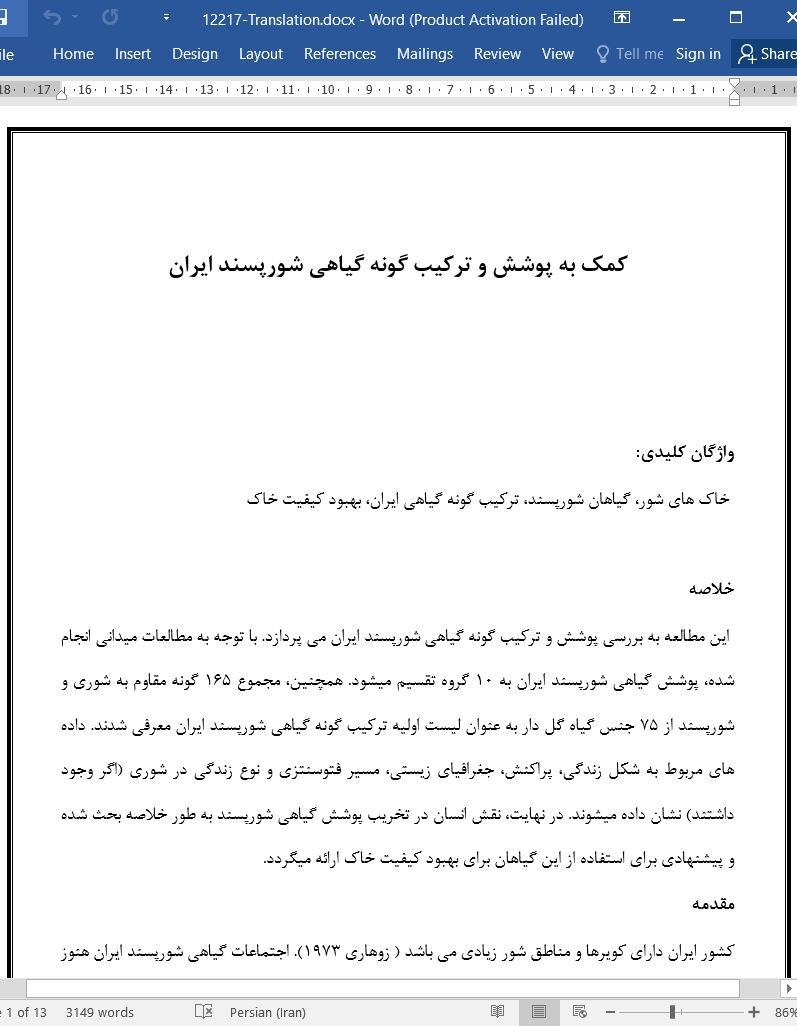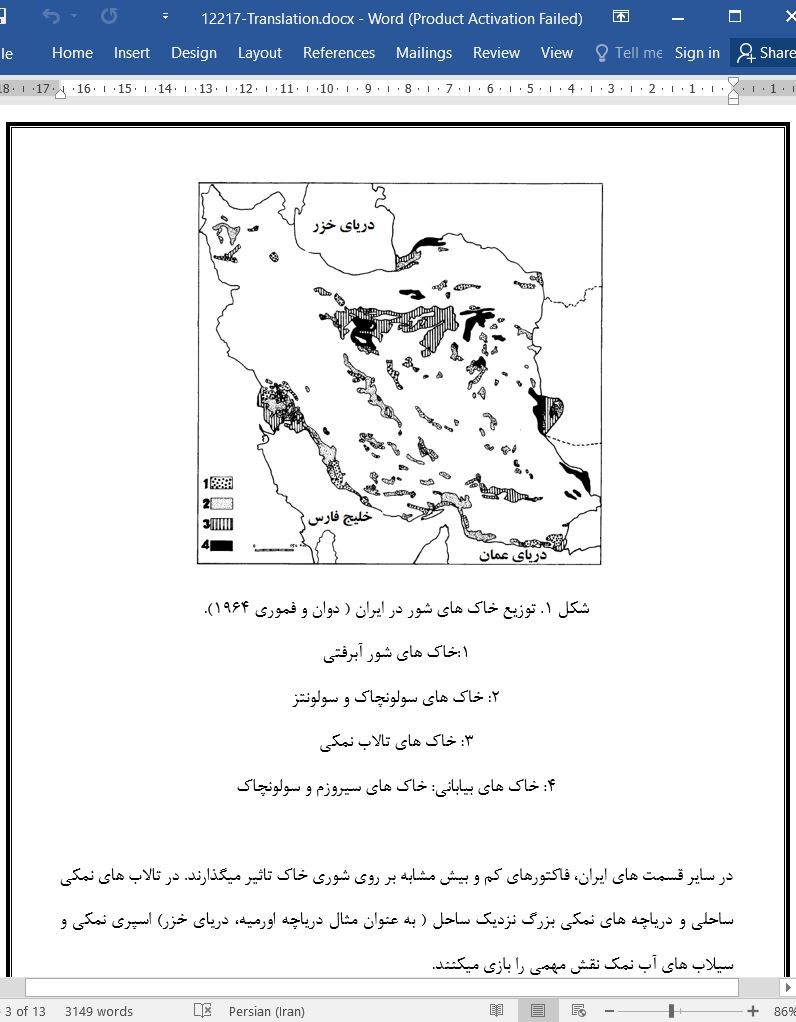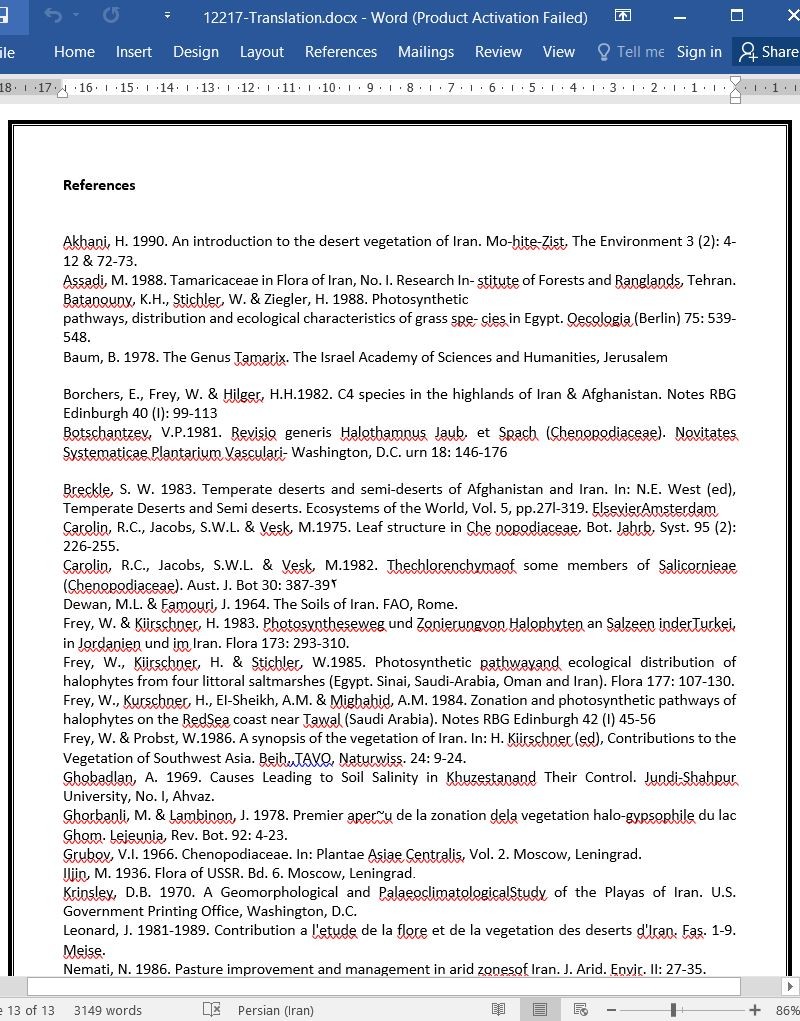
کمک به پوشش و ترکیب گونه گیاهی شورپسند ایران
خلاصه
این مطالعه به بررسی پوشش و ترکیب گونه گیاهی شورپسند ایران می پردازد. با توجه به مطالعات میدانی انجام شده، پوشش گیاهی شورپسند ایران به 10 گروه تقسیم میشود. همچنین، مجموع 165 گونه مقاوم به شوری و شورپسند از 75 جنس گیاه گل دار به عنوان لیست اولیه ترکیب گونه گیاهی شورپسند ایران معرفی شدند. داده های مربوط به شکل زندگی، پراکنش، جغرافیای زیستی، مسیر فتوسنتزی و نوع زندگی در شوری (اگر وجود داشتند) نشان داده میشوند. در نهایت، نقش انسان در تخریب پوشش گیاهی شورپسند به طور خلاصه بحث شده و پیشنهادی برای استفاده از این گیاهان برای بهبود کیفیت خاک ارائه میگردد.
مقدمه
کشور ایران دارای کویرها و مناطق شور زیادی می باشد ( زوهاری 1973). اجتماعات گیاهی شورپسند ایران هنوز در میان پوشش های گیاهی قرار دارند که کمتر شناخته شده اند و دلیل آن مربوط به عدم وجود اطلاعات به روز شده در مورد آنها و علاقه اکثر گیاه شناسان و اکولوژیست ها به زیستگاه های گیاهی فاقد شوری یا با شوری کم می باشد. دانش ما درباره لیست گیاهان شورپسند محدود به مطالعه رچینگر (1963) با عنوان "فلور ایرانیکا" می باشد، هرچند که در این مطالعه به ندرت به بررسی زیستگاههای گیاهی پرداخته میشود. همچنین مطالعاتی در مورد کمک های محلی به نواحی بیابانی ایران صورت گرفته است مانند مطالعات رچینگر و وندلبو (1976)، رچینگر (1977)، قربانلی و لامبینون (1978)، لئونارد (1981-1989) و آخانی (1990).
Abstract
An account is given of the halophytic vegetation and flora of Iran. With respect to field studies the halophytic vegetation of Iran is classified into 10 vegetational units. Also, a total of 165 halophytic and salt tolerant species within 73 genera of flowering plants are recognized as a first provisional list of the halophytic flora of Iran. Some data on the life form, distribution, chorotype, halotype and photosynthetic pathway (if available) are given. Finally the role of man in destroying the halophytic vegetation is briefly discussed and a proposal is made to use some of the halophytes for soil improvement.
1. Introduction Iran is the classical country of great salines and Kavirs (Zohary 1973). Halophytic communities of Iran are still among the most poorly known vegetation units in Iran. This is mainly due to the absence of up-to-date information on the halophytes and the interest of most botanists and ecologists in the rich flora of low-salt or salt-free habitats. Our knowledge of the list of halophytes is restricted to Flora Iranica (Rechinger 1963) where, however, habitats of the plants are rarely given; as well as the local contributions on the desert areas of Iran, such as: Rechinger & Wendelbo (1976), Rechinger (1977), Ghorbanli & Lambinon (1978), Leonard (1981-1989) and Akhani (1990).
خلاصه
1.مقدمه
2. ویژگیهای فیزیکی-جغرافیایی
3. انواع پوشش گیاهی شورپسند
3.1. اجتماعات گونه Halocnemum strobilaceum در کویرهای نمکی گل آلود
3.2. اجتماعات گیاهی شورپسند اجباری
3.3. اجتماعات تاماریکس (گز)
3.4 اجتماعات شورپسند و آب دوست
3.5. اجتماعات مانگروو (جنگل های ساحلی)
3.6. اجتماعات گیاهی شورپسند آبزی
3.7. اجتماعات درختچه ای شورپسند در خاک های شور و خشک
3.8. اجتماعات Herbaceous perennial و Hemicryptophyte halophytic
3.9. اجتماعات گیاهان شورپسند ساکن مناطق خشک با گیاهان خشکی زی مقاوم به شوری
3.10 اجتماعات گیاهان شورپسند یکساله
4. گیاهان بومی شورپسند ایران
5. انسان و پوشش گیاهی شورپسند در ایران
منابع
Abstract
1. Introduction
2. Physico-geographical features
3. Halophytic vegetation types
3.1. Halocnemum strobilaceum communities on muddy salt flats
3.2. Obligatory hygro-halophytic communities
3.3. Tamarix communities
3.4. Hydrophilous euryhalophytic communities
3.5. Mangrove communities
3.6. Hydrohalophytic plant communities
3.7. Halophytic shrub communities on salty anddry soils
3.8. Herbaceous perennial and hemicryptophytehalophytic communities
3.9. Xerohalophytic communities with salt-tolerantxerophytes
3.10. Annual halophytic communities
4. The halophytic flora
5. Man and halophytic vegetation in Iran
References
- ترجمه فارسی مقاله با فرمت ورد (word) با قابلیت ویرایش، بدون آرم سایت ای ترجمه
- ترجمه فارسی مقاله با فرمت pdf، بدون آرم سایت ای ترجمه



